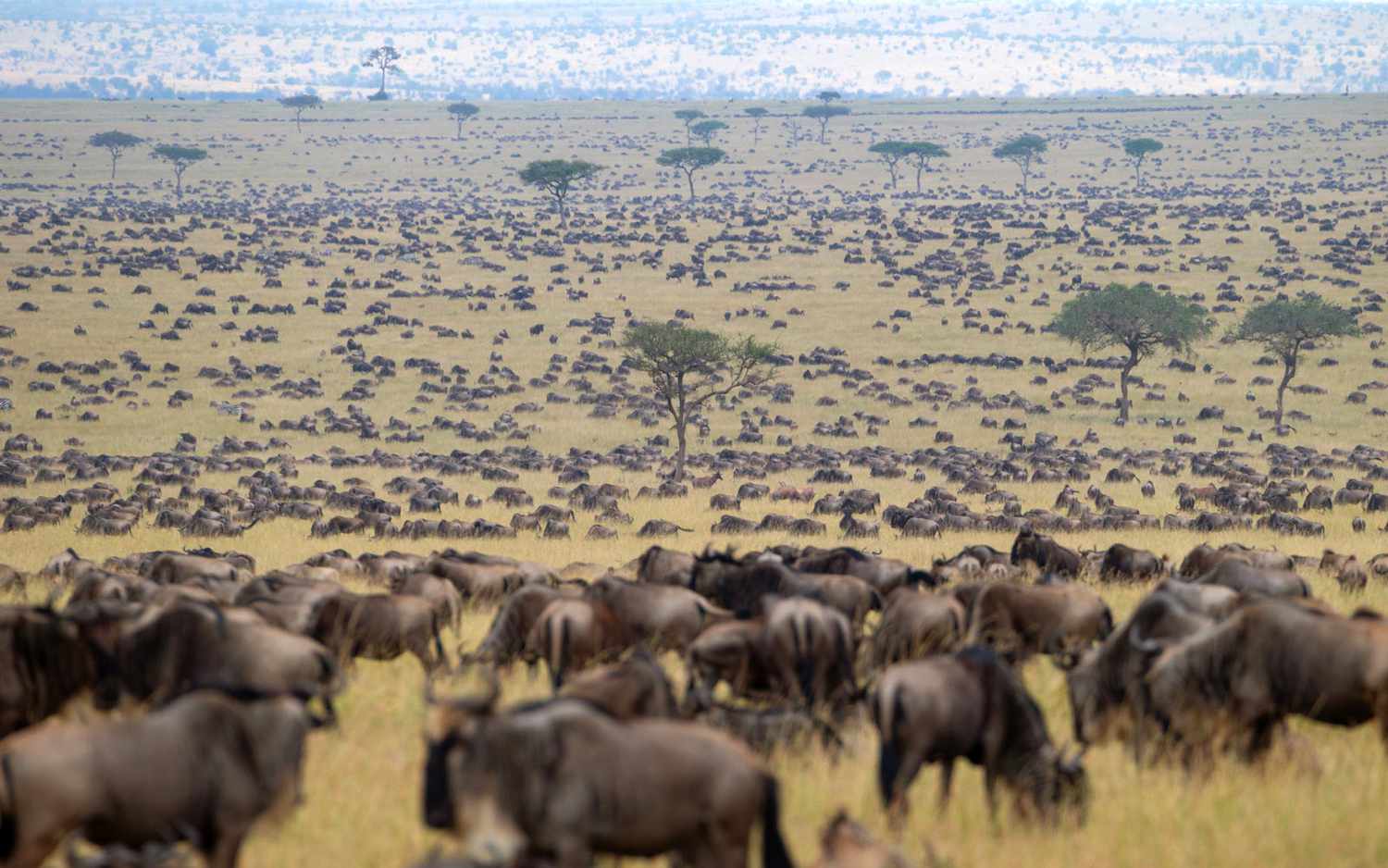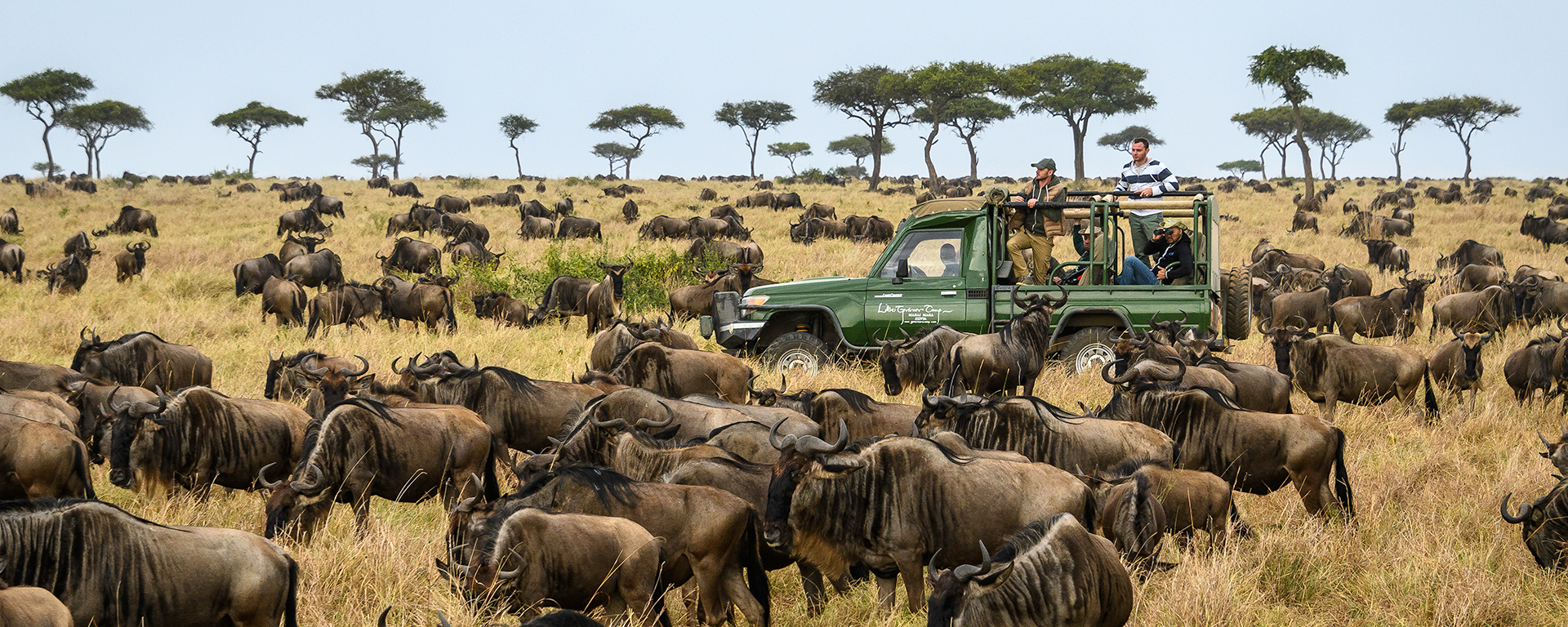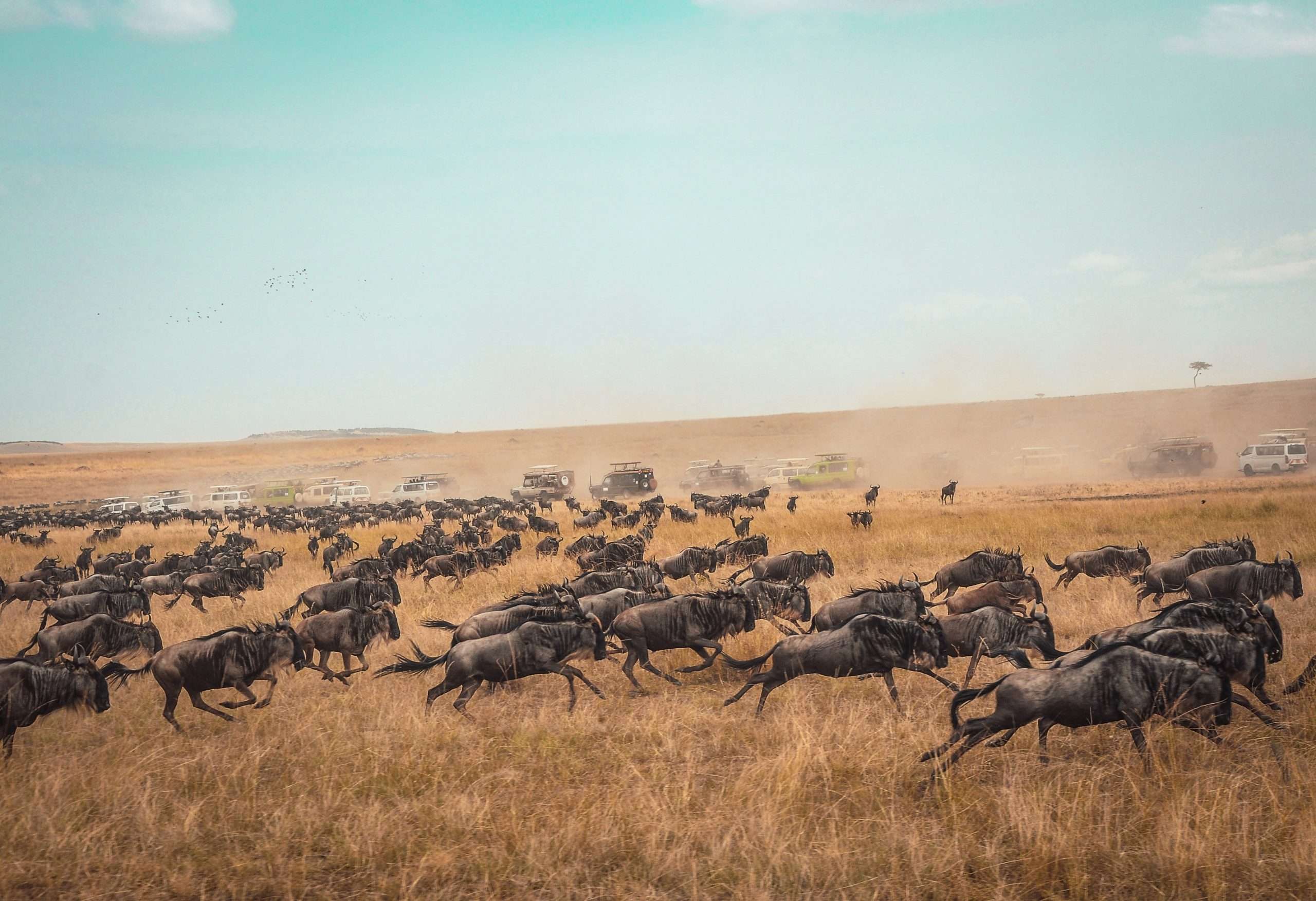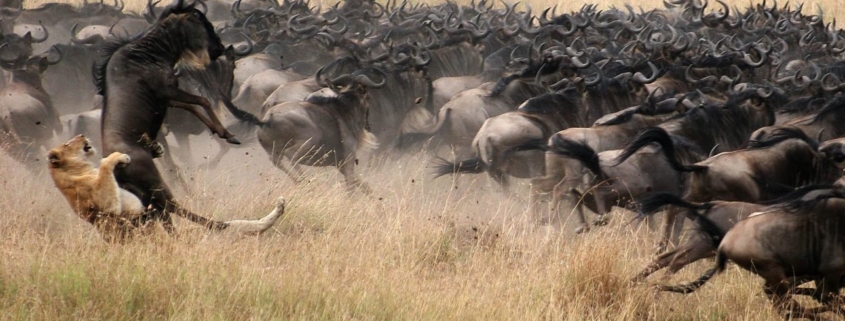Kenya Great Migration Safari #1
Kenya Great Migration Safari
Nothing on Earth compares to it. A vast congregation of wildlife, numbering in the millions, steadily advancing along an age-old path of survival. Their unceasing quest for taller, fresher pastures propels these herds of herbivores – comprising wildebeests, zebras, gazelles, and others – on an unbroken migration spanning all twelve months of the year, forming a cycle as predictable as the changing seasons themselves.
Originating from the calving grounds in the southern reaches of the Serengeti, these enormous assemblages of plains-dwelling creatures follow a clockwise trajectory into Kenya’s Masai Mara, returning to Tanzania later in the year. This grand circular journey represents a mutually beneficial relationship between the grazers, the ecosystems they traverse, and the countless predators patiently awaiting them at every juncture.
The entire odyssey brims with anticipatory tension, not just due to the overwhelming numbers of wildlife involved but also because of the intertwined cycles of life and death that unfold along the way.
In the throes of the birthing season, the Serengeti fields witness the arrival of up to half a million newborn wildebeests. Nearby, predators such as lions, leopards, cheetahs, jackals, and African wild dogs continually patrol the vicinity, driven by their instinctual pursuit of sustenance. As dictated by nature, not everyone emerges triumphant from this timeless voyage.
The Migration’s Astonishing Numbers
When we delve into the realm of wildlife that constitutes the awe-inspiring phenomenon known as the Kenya Great Migration Safari, the sheer numbers are nothing short of astounding. This majestic planetary journey through East Africa comprises approximately 1.5 million wildebeests, half a million gazelles, 300,000 zebras, and 18,000 eland antelope, alongside other species like topi.
Spanning a grand arc from Tanzania’s Serengeti to Kenya’s Masai Mara and then retracing their steps, this migratory path covers around 1,000 kilometers (620 miles), traversed diligently month by month throughout the year. It’s an arduous test of the animals’ endurance, with only the fittest surviving the constant threat posed by the apex predators. Perils such as perilous river crossings, where lurking crocodiles lie in ambush, add to the challenges of this remarkable journey.
In a captivating twist of evolution, each group of grazers specializes in consuming distinct portions of the grasslands they encounter. Zebras, for instance, prefer the taller grasses, while wildebeests tend to graze on the shorter varieties. In a remarkable example of natural symbiosis, it is believed that the saliva from these herds stimulates new growth in the grasses.
Driven by an innate sense of the rains gracing the plains ahead, the animals seem to possess an instinctual knowledge that fresh pastures will follow, shaping their very own natural route.
Month By Month Through The Great Migration
Much like the seasons of our own lives, each stage serves a distinct purpose in the grand tapestry of the Great Wildebeest Migration. From the moment of birth and the journey of maturation, to the northward migration during the summer months, and the eventual return, every season is marked by its own special and unique phases.
Kenya Great Migration Safari; January, February, and March – The Birthing Season
As the Kenya Great Migration Safari progresses southward from the Masai Mara and northern Serengeti, it enters the Ngorongoro Conservation Area, a remarkable ecosystem encompassing the colossal Ngorongoro Crater, the world’s largest and most pristine volcanic caldera. Following the seasonal rains, the grasses in this area flourish, attracting the wildebeest mothers seeking nutrient-rich sustenance to gestate and nurture their newborns.
These herds also assemble near Olduvai Gorge, a site of immense anthropological significance. Between these two regions, a staggering 500,000 wildebeest calves are born from January to March. If you visit during this period, you’ll find yourself amidst the birthing fields where up to 8,000 calves enter the world each day.
However, as previously mentioned, the spectacle of this newborn activity is met with an equally riveting presence of predators drawn to the scene by the thousands of vulnerable animal offspring. What unfolds next is a dynamic interplay between the predators’ relentless tactics and the protective instincts of the wildebeest mothers. This intense drama unfolds repeatedly across these expansive fields.
Kenya Great Migration Safari; April, May & June – The Mating Season
Newborn wildebeests display remarkable resilience, as they can stand almost immediately after birth and join the herd within just a few days. With a month or two to mature, by April, the herds commence their northwestward journey towards the abundant grasslands of Serona, located in the central Serengeti. Along the way, they are joined by thousands of zebras and antelopes.
It’s important to note that the migration’s precise route varies from year to year, contingent upon the richness of the grasses and the availability of water.
As the great processions of the migration extend for several kilometers, May marks the onset of the mating season, a spectacle in which male wildebeests engage in head-to-head combat for mating rights.
Subsequently, the herds change direction, heading towards the western corridor of the Serengeti, where they approach the Grumeti River for their initial river crossing. This phase unfolds with heightened intensity, as the animals gather in substantial numbers at the river’s edge, their anticipation mingled with nervousness in the face of the perils that lie in the unfamiliar waters, where crocodiles lie in ambush.
Kenya Great Migration Safari; July, August & September – The Great Migration
The migrating herds exhibit a dynamic pattern as they journey north, not moving as a single massive group. Some contingents veer off towards the Grumeti Reserve, while many others persist in their northward trajectory towards the lush pastures of Kenya’s Masai Mara.
By the time July arrives, many thousands of wildebeests and zebras approach a more extensive and perilous river crossing, the Mara River. Sensing the lurking dangers beneath the water’s surface, the animals become agitated – some summon the strength to make a daring leap across the river, others fall short, disappearing beneath the waters and swept away by the powerful current, while still others fall victim to the chaotic frenzy of the moment.
This river crossing stands as one of the most awe-inspiring wildlife spectacles. It offers a front-row view of nature in its most unbridled form, as herbivores and predators alike grapple for their survival. It’s important to note that around 250,000 wildebeests meet their demise during the migration months, accounting for approximately a sixth of the total population. These fatalities can result from not only the river crossings but also thirst, starvation, and exhaustion.
As tragic as these deaths may appear to us, they are an intrinsic part of the natural order. Scavengers feed on the carcasses, providing significant nutrients to the surrounding ecosystem.
By late July and August, a significant portion of the herd has successfully traversed the Mara and Talek Rivers, advancing through the northern expanses of the Masai Mara during the Kenya Great Migration Safari. For those that have accomplished these river crossings, persistent threats arise from the numerous predators lurking in the Mara.
As September unfolds, the frequency of river crossings subsides, and the expansive waves of migrating wildlife shift eastward, perpetually in pursuit of fresh and nourishing grasslands.
Kenya Great Migration Safari; October, November, & December – Another River Crossing
Arriving in October and early November for the Kenya Great Migration Safari, the short rains usher in a significant shift in the herds’ direction, guiding them southward once more, with their ultimate goal being another perilous crossing of the Mara River. They march on to the eastern fringes of the Serengeti, renowned for its high frequency of cheetah sightings.
By December, the immense herds disperse throughout the eastern and southern regions of the Serengeti. The impact of the short rains is evident here, and from December into January and beyond, the southern Serengeti becomes a haven of lush vegetation, alluring wildebeests, zebras, gazelles, and other grazers as the birthing season approaches.
Before long, these expansive plains will witness a monumental calving event as the resident wildlife, including predators, give birth to their offspring. During this period, you can not only witness the arrival of baby wildebeests, zebras, gazelles, monkeys, giraffes, and more, but it’s also an ideal time to spot lion, leopard, and cheetah cubs.
And thus, the timeless cycle of the Kenya Great Migration Safari persists, as it has for generations, with all of nature’s forces competing, cooperating, recycling, and securing the continuity of life throughout this incredibly diverse and rich landscape.



